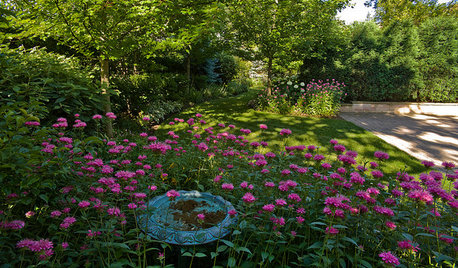Stopping field bind weed
s10sleeper
12 years ago
Related Stories

EDIBLE GARDENSNatural Ways to Get Rid of Weeds in Your Garden
Use these techniques to help prevent the spread of weeds and to learn about your soil
Full Story
GARDENING GUIDES5 Ways to Naturally Win the Weed War
Show irksome weeds no mercy with these tricks for combating them sans chemicals
Full Story
GARDENING GUIDESLet's Weed Out 4 Native Plant Myths
Plant wisely for a garden that supports pollinators and requires less work
Full Story
GARDENING GUIDESHow to Stop Worrying and Start Loving Clay Soil
Clay has many more benefits than you might imagine
Full Story
GARDENING GUIDESField Trip: Gather Ideas on a DIY Garden Tour
Get inspired by one gardener's local tour, then check out her suggestions for unofficial tours of your own
Full Story
GARDENING FOR BUTTERFLIES3 Ways Native Plants Make Gardening So Much Better
You probably know about the lower maintenance. But native plants' other benefits go far beyond a little less watering and weeding
Full Story
GARDENING FOR BUTTERFLIESA Quick-Start Guide to Bird-Watching for Fun and Learning
Set out some seed and grab your field guide. Bird-watching is an easy, entertaining and educational activity for the whole family
Full Story
GARDENING GUIDES7 Ecofriendly Gardening Ideas That Also Cut Chore Time
Spend less time weeding, less money watering and more moments just sitting back and enjoying your healthy garden
Full Story
LANDSCAPE DESIGNExuberant Self-Seeders for Gorgeous, Easy-Care Gardens
Keep weeds down, color high and maintenance low with beautful plants that sow themselves
Full Story
GARDENING GUIDESGreat Design Plant: Milkweed
Quit cringing. This not-weed plant is a sight to behold in the garden, has a delicious vanilla scent and is a magnet for butterflies
Full Story






david52 Zone 6
Laurel Zito
Related Professionals
Chattanooga Landscape Architects & Landscape Designers · Clark Landscape Architects & Landscape Designers · Allentown Landscape Contractors · Burlington Landscape Contractors · Cerritos Landscape Contractors · Mesa Landscape Contractors · Methuen Landscape Contractors · Oklahoma City Landscape Contractors · Parkland Landscape Contractors · Plainview Landscape Contractors · Severna Park Landscape Contractors · South Lyon Landscape Contractors · Vineyard Landscape Contractors · Reisterstown Landscape Contractors · Larkspur Decks, Patios & Outdoor Enclosuress10sleeperOriginal Author
toxcrusadr
dottyinduncan
s10sleeperOriginal Author
rott
Laurel Zito
s10sleeperOriginal Author
Laurel Zito
Kimmsr
Laurel Zito
david52 Zone 6
Laurel Zito
s10sleeperOriginal Author
david52 Zone 6
Laurel Zito
s10sleeperOriginal Author
Karchita
david52 Zone 6
Laurel Zito
s10sleeperOriginal Author
whitecap2
tarbucky
tarbucky
pnbrown